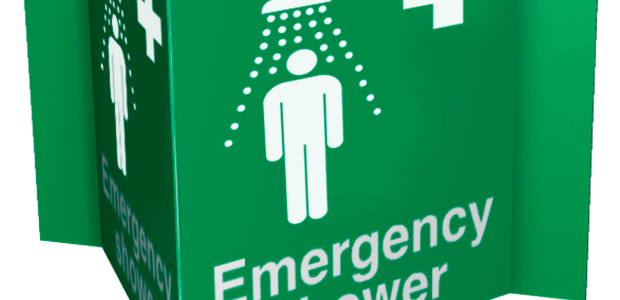
Testing and Inspecting Your Emergency Equipment
Here's what the key eyewash and shower standard, ANSI/ISEA Z358.1-2014, says about weekly tests and annual inspections of the equipment.
- By Fred Elliott
- May 01, 2017
The key emergency eyewash and shower consensus standard is ANSI/ISEA Z358.1-2014. It sets guidelines for the installation, use, and maintenance of this emergency equipment, which OSHA requires to be made available to workers who could be exposed to harmful corrosive materials. "Where the eyes or body of any person may be exposed to injurious corrosive materials," the agency's 29 CFR 1910.151 standard says, "suitable facilities for quick drenching or flushing of the eyes and body shall be provided within the work area for immediate emergency use."
This emergency equipment must be inspected annually to ensure it complies with the Z358.1-2014 standard and also must be activated weekly to make sure it is operational in case of emergency and to flush out sediment that may be in the supply line. The testing should be done for as long as necessary to ensure there is flushing fluid supply at the device’s delivery head and to clear sediment.
In line with these weekly activation tests, makers of emergency equipment recommend immediately replacing any broken or inoperative parts on the equipment; checking to make sure an appropriate flushing system is within 10 seconds’ travel distance, or about 55 feet, from the hazard; protecting the equipment and supplies against freezing or extremely hot temperatures; and also removing obstructions or trip hazards, if any, found between the hazard and the equipment.
Special considerations should be made for employees who have a disability and also for work areas where highly injurious substances are handled.
Questions to ask during your weekly activation tests include these:
- Is the fluid clear?
- Are the jets working properly?
- Is the area around the eyewash station clear of obstructions?
- Is there a bucket placed under the eyewash to collect runoff?
- Are there any leaks?
As the location recommendation makes clear, we should stress to employees during their training that the first 10 seconds are critical after their eyes or skin has been exposed to a corrosive substance because delaying treatment even for a few seconds may cause serious injury. Emergency eyewash/shower stations are designed to allow workers to flush away accidental chemical exposures rapidly.
Using an eyewash station for a 15-minute flush of the eyes is considered a first aid measure; make sure you conduct a hazard assessment first to determine the chemical hazards at your workplace and to determine how workers will use the eyewash stations during an emergency.
Other documents to consult when determining the need for and locations of eyewash and shower equipment include the NIOSH Pocket Guide to Chemical Hazards1 (its mobile app is highly useful) and also safety data sheets for chemicals in use at your facility.
The Industrial Safety Equipment Association's guide to selection, installation, and use of eyewash and shower equipment2 (February 2015) is a 23-page handbook offering an inspection checklist, definitions of each equipment type, a list of equipment suppliers, and FAQs such as these:
Q: Do I need my eyewash/shower device third-party certified after installation?
No. Third party certification is obtained by manufacturers of eyewash and shower equipment. ISEA members built this requirement into the standard to demonstrate their commitment to quality and end user safety.
Q: Where will tepid water come from?
Tepid water can come from different sources. Temperatures in excess of 38° C (100° F) have proven to be harmful to the eyes and can enhance certain chemical interaction with the skin and eye tissue. Recent information indicates that a temperature of 16° C (60° F) is suitable for the lower parameter for tepid flushing fluid without causing hypothermia to the equipment user.
The standard contains performance specifications for control valves such that emergency equipment will operate in 1 second or less and remain in operation until intentionally closed.
Inspection Items
The inspection should include these items, according to the ISEA guide:
- Is the emergency equipment installed as the manufacturer's instructions recommend?
- Can employees who may be exposed to hazardous chemicals reach the equipment within 10 seconds from the location of the hazard?
- Is the equipment on the same level as the hazard area, and is the path between them unobstructed?
- Is a highly visible sign in place indicating the location of the emergency equipment?
- Is it delivering tepid flushing fluid?
- Does the fluid flow rate meet the requirements of the equipment being tested?
- Does the valve remain open without the use of the operator’s hands?
Tallying Eye Injuries
Even "minor" eye injuries can cause lifelong vision problems, and there are hundreds of eye injuries every day in the United States, NIOSH's online Eye Safety Tool Box Talk Instructor's Guide3 points out. It recommends following the hierarchy of controls for preventing them—using engineering and administrative controls rather than relying solely on personal protective equipment.
How many eye injuries are we talking about? During 2014, sprains, strains, and tears were the leading injury in private industry and state and local government in the United States, according to the federal Bureau of Labor Statistics. There were 420,870 lost-time cases in that year, and 23,730 of those were eye injury cases. But we know most of those were not cases where employees suffered eye injuries caused by corrosives and could have availed themselves of eyewash and shower equipment. Only 3,750 of the lost-time cases during the year were classified as chemical burns, according to BLS.4
References
1. https://www.cdc.gov/niosh/npg/
2. https://safetyequipment.org/wp-content/uploads/2015/05/EWS-Guide-Feb_2015.pdf
3. https://www.cdc.gov/niosh/topics/eye/toolbox-eye.html
4. https://www.bls.gov/opub/ted/2015/type-of-injury-or-illness-and-body-parts-affected-by-nonfatal-injuries-and-illnesses-in-2014.htm
This article originally appeared in the May 2017 issue of Occupational Health & Safety.